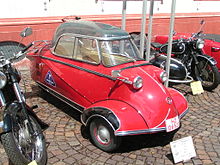
Definition
Typical microcars usually have some of the following features:
- seats only the driver and a single passenger
- a 1 cylinder 49 – 500cc engine
- 1 wheel drive
- cable operated brakes on 2 or 4 wheels (no longer permissible in countries such as the UK)
- simple suspensions
- 6″ - 8″ roadwheels
- Three-wheeled.
- Not fitted with a reverse gear (the weight of the car was light enough for parking to be achieved by lifting one end of the vehicle).
- May have all gears operable in reverse as well as in forward gear such as the Messerschmitt KR200.
- Fitted with lifting bodywork instead of doors.
- Less than 3m in length (sometimes less than 8′, 2.440m).
- Less than 85 cubic feet/2400 litres interior volume.
Legal position
The economy of operating such a small car (mostly in fuel and tires) has also often been helped by three-wheeled microcars or cars with very small engines being treated as motorcycles for tax and insurance purposes.In some countries, microcars with a certain maximum weight are considered motorcycles and therefore no car driving licence is needed (Austria, France, Germany, Spain, Italy). This assures a certain market among older people who do not want to stand for, or who cannot pass an auto driver's licence test. More negatively, at least in Austria and France, such cars are sometimes derided as a solution for people who had their licence revoked because of drunk driving.
In some European countries, taxes formerly depended on engine displacement, and/or insurance rates depended on power. This has given rise to names of such cars as Citroën 2CV and Renault 4CV. This favourable treatment by governments is based on the benefits to a society of reducing use of such resources as minerals, parking space and foreign exchange, reduced noise and chemical pollution, reduced hazard to others (they are slow vehicles) etc. Reduced global warming from carbon dioxide emission has now been added to this list.
Another advantage is the ease of parking. Some microcars can be parked perpendicular, where other cars park parallel, or be lifted by hand, like a motor scooter, to get into a tight spot. The Isetta and some others had forward entry, to facilitate perpendicular parking close to other vehicles. The Myers Motors NmG (originally called the Corbin Sparrow) is licensed as a motorcycle and parked in motorcycle spaces in California, and probably in other places.
The small size improves handling by reducing the angular inertia. The Messerschmitt and Spatz have been described as much better than ordinary cars on snow and ice. Spare room on the road and ease of missing obstacles are also improved.
For the performance oriented, who prefer more than two wheels and a roof, the scaling laws show that one need not give up acceleration until the curb weight comes down to around the driver's weight, because power per weight of the car itself improves with small size, in an otherwise similar design. Top speed is lost with small scale, due to the decreased Reynolds number, but this is a small effect. The Messerschmitt TG500 had about a 78 mph (126 km/h) top speed with 15 kW (20 horsepower) and excellent aerodynamics.
In the UK before October 2000, a person who passed a motorcycle test was automatically granted a full sub-category B1 licence (lightweight car with an unladen weight of 550 kg or less, motor quadricycle, motor tricycle) as an additional entitlement with the full Category A (motorcycle) licence. Since 2000 a provisional car licence has to be requested.
The last major UK manufacturer, Reliant, ceased production of these vehicles in 1998.
Electric microcars
Some examples of battery electric microcars are:- The Think Nordic, imported to the USA by Ford Motor Company to satisfy California Zero-emissions vehicle (ZEV) requirements in the state of California. Removed from the market by Ford in a bargain with the California Air Resources Board. See PZEV for more information.
- The Global Electric Motorcars GEM, a 2- or 4-passenger "Golf car" style vehicle.
- The REVA electric vehicle as used in its home environment, India. This may soon be exported to the USA with speed electronically limited and sold as an NEV.
- The Corbin Sparrow, a single-seat electric microcar that can be licensed as a motorcycle.
- The CityEl, a three-wheeled single-seat electric microcar built in Germany.
- The French company SECMA produces the so-called scootcar FUN-ELEC.
- The TWIKE is a microcar that is pedal assisted.
- Electrocar is a small freight transporter typically used in enterprises or rail stations
- the 2012 PeelP50 comes in electric as well as the classic one cylinder gasoline.
Microcars by country of origin
Microcar makers
- Aixam
- Bamby Cars
- Bellier
- Berkeley
- Casalini
- Chatenet: Barooder S2, Barooder X2 MUST Barooder Sport (diesel, 4 kW), Barooder X4 and Speedino (gasoline, 15 kW).
- CQ Motors
- 4 Seasons Velos
- Grecav: Sonique
- Hafei
- Ligier
- Litecars
- Microcar make.
- Micro-Vett (Ydea electric).
- Mitsuoka
- Peel Engineering Company
- Piaggio
- Rodley
- Scootacar
- Renault (Twizy)
- REVA
- SECMA
- Sharp's Commercials
- Simpa-JDM : Albizia basic, club and confort.
- Shuanghuan Noble Four seat front engine look-alike to the Smart car.
- Smart
- Takeoka
- Tata Nano
- Town Life
- WeatherVelo
- Zundapp Motors
See also
- List of microcars by country of origin
- Battery electric vehicle
- Bubble car
- City car
- Cyclecar
- Car classification
- Economy car
- Kei car a Japanese category of small vehicles, including passenger cars, vans, and pickup trucks.
- Low-energy vehicle
- MIT Car
- Neighborhood Electric Vehicle
- Vehicle size class
- Velomobile
Source: Internet



